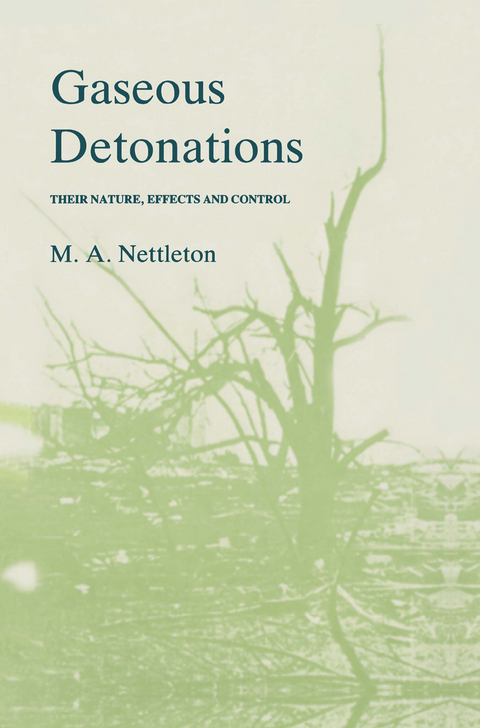
Gaseous Detonations
Chapman and Hall (Verlag)
978-0-412-27040-6 (ISBN)
1 Introduction.- 1.1 General remarks.- 1.2 Definitions of commonly-used terms.- 1.3 Unidimensional models of detonations.- 1.4 Structure of a detonation wave.- 1.5 Philosophy of presentation.- 2 Unidimensional models.- 2.1 Introductory remarks.- 2.2 Properties of unidimensional shock waves.- 2.3 Properties of unidimensional shock waves with energy addition.- 2.4 Properties of the Chapman-Jouguet state.- 2.5 Comparison of C–J predictions and experiment.- 2.6 The Zel’dovich, von Neumann, Doring model.- 2.7 Comparison of the ZND model and experiment.- 2.8 The Taylor expansion wave.- 2.9 Concluding remarks.- 3 Structure of detonation fronts.- 3.1 General remarks.- 3.2 ‘Spinning’ detonation fronts.- 3.3 ‘Galloping’ fronts.- 3.4 Experimental studies of multi-headed fronts.- 3.5 Theoretical treatments of multi-headed fronts.- 3.6 Concluding remarks.- 4 Detonable media.- 4.1 General remarks.- 4.2 Confined and unconfined detonations.- 4.3 Gases and vapours which are detonable in the absence of an oxidant.- 4.4 Comparison of detonation limits for confined and unconfined detonations with flammability limits for mixtures of hydrocarbons with oxygen and air.- 4.5 Homology hypothesis for predicting detonation limits.- 4.6 Detonations with oxidants other than oxygen.- 4.7 Influence of initial pressure and temperature on detonability.- 4.8 Influence of additives on detonability.- 4.9 Detonations in suspensions of dusts and droplet mists in oxidizing atmospheres.- 5 Initiation of a detonation wave.- 5.1 General remarks.- 5.2 Initiation of confined detonations by shock waves.- 5.3 Initiation by blast waves from electrical and laser sparks and charges of conventional explosives.- 5.4 Detonations in large unconfined clouds of vapour.- 5.5 Minimum ignition energies.- 5.6 Laminarburning velocities.- 5.7 Expansion ratios.- 5.8 Detonations arising from accelerating flames.- 5.9 Influence of initial temperature and pressure of the medium on run-up distances.- 5.10 Influence of diameter of pipeline on run-up distances.- 5.11 Effect of additives on pre-detonation distances.- 5.12 Effects of surface roughness and obstacles on the acceleration of confined flames.- 5.13 Pressure piling (cascading).- 5.14 Concluding remarks.- 6 Interaction of a detonation with confinement.- 6.1 Introductory remarks.- 6.2 Diffraction at an isolated wall, ?w < 0°.- 6.3 Diffraction at an isolated wall, 0° < ?w < ?crit.- 6.4 Diffraction at an isolated wall, ?crit < ?w < 90°; standard two- and three-shock theory for non-reactive media and the effects of reaction.- 6.5 Normal reflection of a detonation wave.- 6.6 Transmission of a planar detonation wave through an abrupt expansion in area.- 6.7 Propagation of detonations through bends and junctions.- 6.8 Interaction of a detonation with an inert surrounding gas.- 6.9 Refraction of detonations in mixtures of different composition.- 6.10 Concluding remarks.- 7 Damage caused by detonations.- 7.1 Introduction.- 7.2 Early experiments on effective pressures generated by detonations.- 7.3 Damage produced by detonations in chemical plant.- 7.4 Experimental studies of failure resulting from detonations.- 7.5 Concluding remarks.- 8 Prevention and mitigation of detonations.- 8.1 Introductory remarks.- 8.2 Inhibition of flames of normal burning velocity.- 8.3 Venting in the early stages of an explosion.- 8.4 Quenching of flame-shock complexes.- 8.5 Suppression of detonations.- 8.6 Mitigating the effects of detonations.- 8.7 Concluding remarks.- 9 Concluding recommendations.- 9.1 Introductory remarks.- 9.2 Stress waves inconfining walls.- 9.3 Planned deformations as safety measures.- 9.4 Designing to minimize the effects of local peaks in pressure.- 9.5 Suggestions for further studies of detonations.- References.- Author index.
| Erscheint lt. Verlag | 31.1.1987 |
|---|---|
| Zusatzinfo | XIV, 256 p. |
| Verlagsort | London |
| Sprache | englisch |
| Maße | 155 x 235 mm |
| Themenwelt | Medizin / Pharmazie ► Medizinische Fachgebiete ► Arbeits- / Sozial- / Umweltmedizin |
| Studium ► Querschnittsbereiche ► Prävention / Gesundheitsförderung | |
| ISBN-10 | 0-412-27040-4 / 0412270404 |
| ISBN-13 | 978-0-412-27040-6 / 9780412270406 |
| Zustand | Neuware |
| Haben Sie eine Frage zum Produkt? |
aus dem Bereich


